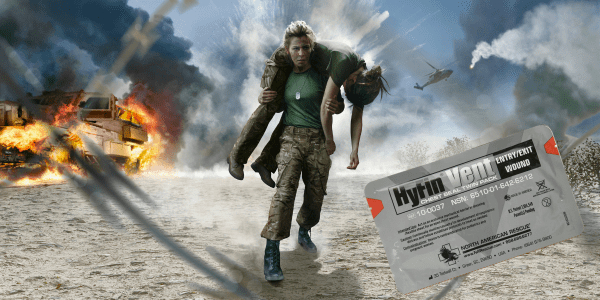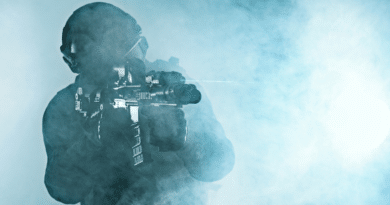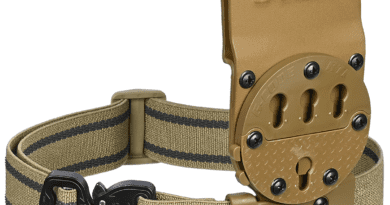Are Chest Seals Truly Necessary in Trauma Kits?
In moments of life-threatening trauma, every second counts. Whether it’s a severe injury sustained in an accident, a gunshot wound, or a puncture to the chest, rapid and effective treatment can make all the difference. Chest seals are a crucial tool that has revolutionized emergency medical care.
Designed to seal chest wounds and prevent potentially fatal complications, chest seals have become an indispensable component of trauma kits. From being a part of kit on plate carriers and battle belts to now being commonly found in EDC trauma kits that people have on them daily, more and more people are discovering the benefits of having this life-saving equipment on them.
Related Article: EDC Medical Kit: More Important EDC Item Than a Firearm?
In this article, we will explore why people need chest seals in trauma kits, dive deeper into their life-saving properties, and provide essential guidance on how to properly use and apply them in critical situations.
Disclaimer: I am not a trained medical professional. This article is for informational purposes only, and you should seek out proper training so that you have the knowledge to go out and help others or yourself. One company that I trust and have taken their medical training course is Iron Forge Consulting Group.
Table of contents
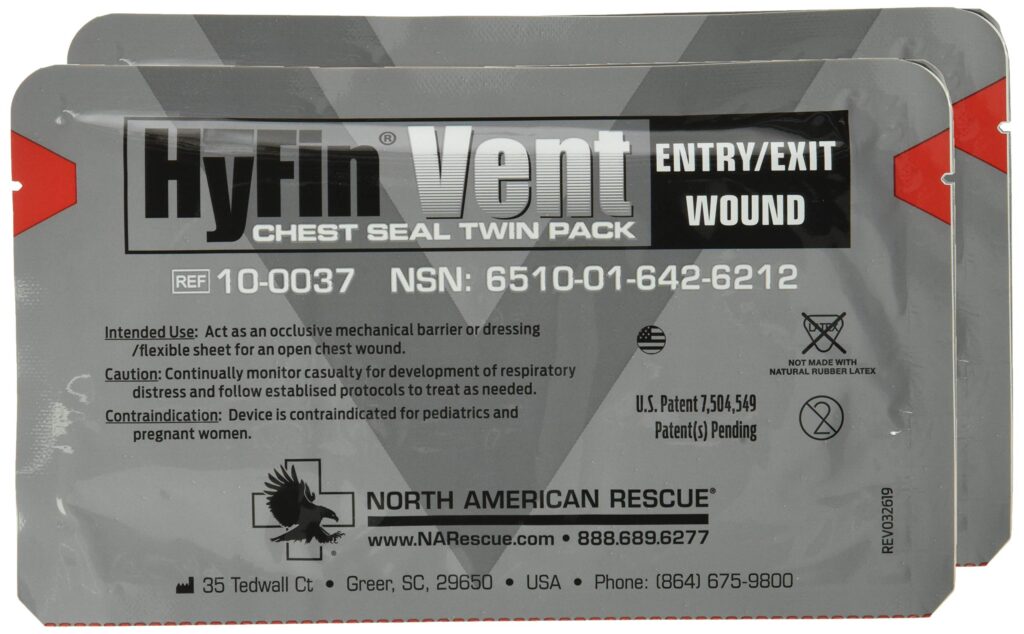
Understanding the Importance of Chest Seals
Most people these days understand the importance of something like a tourniquet when it comes to massive bleeding from extremities. Unfortunately, when an injury, such as a bullet wound, happens in the chest or back, you can’t simply toss a tourniquet on high and tight. That’s where chest seals come in.
Related Article: Should You Carry a CAT Tourniquet as Part of Your EDC?
Additionally, it’s not like you can simply take gauze and shove it in the wound as the cavity you’re pressing it into is nearly endless, and you’ll never (ever) have enough to pack it since it’s a large, open space with several critical organs inside.
We need to truly understand the gravity of chest injuries as well as the role of chest seals in order to preserve life and why we should have them in our trauma kits.
The Gravity of Chest Injuries
When the chest (or back) is injured, particularly through penetrating trauma like gunshot wounds or stab wounds, there is a risk of damaging vital structures within the chest cavity. One of the most severe complications that can arise from chest injuries is tension pneumothorax.
Tension pneumothorax occurs when air accumulates in the pleural space, the area between the lung and the chest wall, causing the affected lung to collapse. This condition can arise when a penetrating injury creates a one-way valve effect, allowing air to enter the chest cavity during inhalation but preventing its escape during exhalation.
Related Article: Live the Creed — Impressive EDC & Battle Belt Med Kits
As the air continues to accumulate, tension pneumothorax puts increasing pressure on the heart and remaining functioning lung, impeding their ability to function properly and putting immense stress on both. Furthermore, this pressure from a tension pneumothorax can also compress major blood vessels, leading to decreased blood flow and potentially causing shock.
Without timely intervention, tension pneumothorax can further deteriorate a patient’s condition, leading to cardiac arrest and even death. This is where chest seals play a crucial role.
Chest seals are designed to create an airtight seal over the wound, preventing the entry of air into the pleural space when breathing. By sealing the chest injury, chest seals help restore normal breathing mechanics and help prevent tension pneumothorax from occurring or worsening. This allows vital organs, including the heart and lungs, to function more effectively, significantly improving the patient’s chance of survival.
In addition to preventing tension pneumothorax, chest seals also help control bleeding and reduce the risk of infection. By creating an occlusive barrier, they minimize the entry of contaminants, such as dirt or bacteria, into the chest cavity, reducing the potential for infection and further complications.
The Role of Chest Seals
The role of chest seals is to effectively seal chest wounds (or penetrating injuries to the back), preventing potentially life-threatening complications and improving the chances of survival in trauma situations.
Below are some key roles and functions of chest seals:
1. Creating an Airtight Seal
Chest seals are designed to create a barrier over chest wounds, forming an airtight seal. As mentioned above, they help restore normal breathing mechanics by sealing the wound and preventing the development or progression of tension pneumothorax.
2. Controlling Air and Fluids
Chest seals also play a crucial role in controlling the movement of air and fluids within the chest cavity. They prevent the entry of air into the pleural space, reducing the risk of lung collapse and minimizing the potential for hemorrhaging from the chest wound. By maintaining the integrity of the chest cavity, chest seals help stabilize the patient’s condition and can improve survival rates.
3. Minimizing Infection Risk
Chest seals act as an occlusive barrier, preventing contaminants from entering into the chest cavity. This reduces the risk of infection and associated complications, which can be particularly significant in cases of open or penetrating chest injuries. By keeping the wound protected and sterile, chest seals contribute to a cleaner and safer environment until medical personnel arrive on the scene.
4. Allowing for Controlled Venting
Some chest seals are designed with a vent or a one-way valve mechanism. These vented chest seals allow trapped air or blood to escape from the chest cavity while still preventing air from entering. Controlled venting can be crucial in cases where there is a buildup of excess air or blood, as it helps relieve pressure and can improve respiratory function, all without compromising the integrity of the seal.
Features and Types of Chest Seals
Once you understand the role and reason for using chest seals, many people may be quick to jump over to Amazon and purchase the first chest seal they find. Unfortunately, putting it in the search will leave you with quite a few results to sort and filter through.
Let’s look at some of the various components and types of chest seals to ensure you make the best buying decision. It should also be noted that it’s recommended that you purchase chest seals from reputable brands, such as NAR Hyfin Chest Seals and HALO Chest Seals.
Key Components of Chest Seals
While not to downplay the construction and quality of chest seals, there really isn’t much that goes into them. In fact, you can use makeshift chest seals in a pinch, but that would mean you need the proper materials.
That being said, the key components of chest seals typically include the following:
Occlusive Material
Chest seals are constructed using an occlusive material that is flexible, transparent, and airtight. This material forms the main barrier over the chest wound, preventing the entry of air and other contaminants into the pleural space.
Adhesive Backing
One side of the chest seal is equipped with a strong adhesive backing. This adhesive allows the seal to adhere securely to the patient’s skin around the wound, ensuring a tight and reliable seal that won’t easily come off or fall off.
Pull Tabs or Release Liners
Many chest seals feature pull tabs or release liners to facilitate quick and easy application. These tabs or liners cover the adhesive side of the chest seal and can be easily removed when applying the seal to the patient’s chest or back.
Vented Design (Optional)
Some chest seals have a vent or a one-way valve mechanism built into their design. This vented design allows trapped air or blood to escape from the chest cavity while still preventing air from entering. Vented chest seals are especially useful in cases where there is a buildup of excess air or blood that needs controlled venting.
What Are the Different Types to Consider?
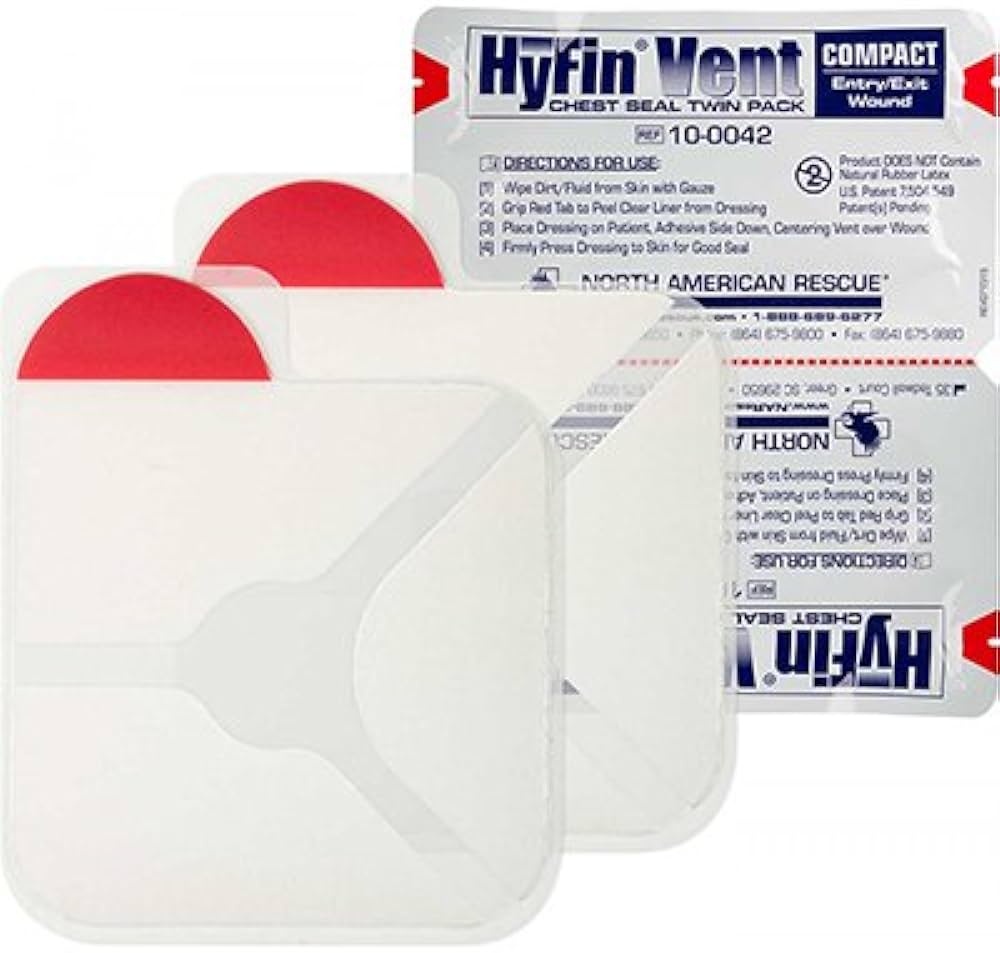
There are several different types of chest seals available, each designed to address specific needs in managing chest puncture injuries.
Related Article: The Halo Chest Seal — An EDC Life-Saving Tool for Chest Trauma
Below are some common types of chest seals:
Non-Vented
These are the most basic and commonly used chest seals. Non-vented chest seals are designed to provide an airtight seal over the chest wound, preventing the entry of air and contaminants into the pleural space.
Vented
Vented chest seals are equipped with a vent or a one-way valve mechanism. These seals allow trapped air or blood to escape from the chest cavity while preventing air from entering. Controlled venting helps relieve pressure and improve respiratory function without compromising the integrity of the seal.
Compact
Compact chest seals are designed to be smaller in size and more portable, making them suitable for use in compact trauma kits or for individual EDC carry med kits. They maintain the same functionality as standard chest seals but with a reduced footprint.
Makeshift
In a pinch, you may need makeshift chest seals that you create using materials around you. One way to create makeshift chest seals is by using a bag or plastic material, cutting it down to size, and then adhering it around a chest or back wound with something like duct tape. Is this ideal? No. Does it work? Yes. It will get the job done until medical professionals arrive on the scene.
Proper Use of Chest Seals in Critical Situations
There is a time and a place for everything. For instance, if Little Johnny falls and scrapes his elbow, you’re not going to run and grab a tourniquet. The same applies to chest seals. If someone gets cut on their chest or back, that doesn’t mean you need to slap a chest seal on. You need to assess the situation and determine if it warrants the use of such.
Let’s dive a little deeper into how to assess an injury and, if it warrants the use of chest seals, how to apply them.
Initial Assessment, Precautions, and Application
When needing to use chest seals, there are critical initial assessments and precautions to consider. Below is an overview:
1. Scene Safety
Before approaching a patient with a chest injury, ensure the scene is safe for both you and the injured person. Assess for any ongoing hazards, such as ongoing violence, traffic, or environmental dangers. Take necessary precautions to protect yourself and others in the vicinity. It is not recommended that you run into danger to treat a casualty. Stop the threat or wait until the scene is safe and then look to take action and help.
2. Personal Protective Equipment (PPE)
Prioritize your safety by wearing appropriate personal protective equipment (PPE). This typically includes disposable gloves to protect both you and the casualty, as well as a face mask if you plan on doing CPR with breaths and don’t know the person, especially if there is a risk of exposure to bodily fluids or bloodborne pathogens. PPE helps reduce the transmission of infections and safeguards against potential contamination.
3. Primary Assessment
Perform a primary assessment of the patient’s overall condition. Assess their level of consciousness, breathing, and circulation. Address any immediate life-threatening issues, such as ensuring an open airway and controlling severe bleeding. Afterward, consider starting CPR if necessary (and only after you stop the bleeding, otherwise, those chest compressions will only more quickly push blood out of their body).
4. Airway Management
Ensure that the patient’s airway is clear and unobstructed. If there are any signs of airway compromise or difficulty breathing, follow appropriate airway management protocols and seek medical assistance as soon as possible. If your kit has an NPA, this may be the time to use one if the situation calls for it.
5. Control External Bleeding
If there is severe external bleeding from the chest injury, apply direct pressure using sterile dressings or your gloved hand to control the bleeding. Direct pressure helps minimize blood loss and helps stabilize the patient’s condition.

6. Expose the Chest
If there is a known chest wound, such as a bullet wound, expose the patient’s chest by removing or cutting through their clothing. This step allows for a clear view of the chest injury and facilitates the proper placement of a chest seal.
7. Cleanse and Prep the Wound (if necessary)
If there are visible contaminants on or around the wound, gently cleanse the area with sterile saline or clean water, if available. Use sterile dressings to cover the wound until the chest seal can be applied.
8. Applying the Chest Seal
Carefully apply the chest seal over the chest wound, ensuring proper alignment and complete coverage of the injured area. Follow the manufacturer’s instructions for proper application, which may involve removing any liners or pull tabs, applying firm pressure to adhere the seal, and ensuring a tight seal around the wound.
9. Reassess and Monitor
After applying the chest seal, reassess the patient’s vital signs, including their breathing and circulation. Monitor for any changes in their condition, such as difficulty breathing, worsening pain, or signs of tension pneumothorax. Regularly reassess the effectiveness of the chest seal and be prepared to adjust or replace it if necessary.
10. Seek Medical Assistance
While chest seals provide crucial initial management for chest injuries, they do not replace the need for medical attention. It is essential to immediately seek professional medical help to ensure appropriate evaluation, further treatment, and ongoing care for the patient.
*Remember, every situation may have unique considerations, and following established protocols and guidelines for trauma management is crucial. The initial assessment and precautions discussed above provide a general framework to approach the use of chest seals, but the specific steps may vary depending on the circumstances and available resources.
Add Chest Seals to Your Trauma Kits and Know How to Use Them
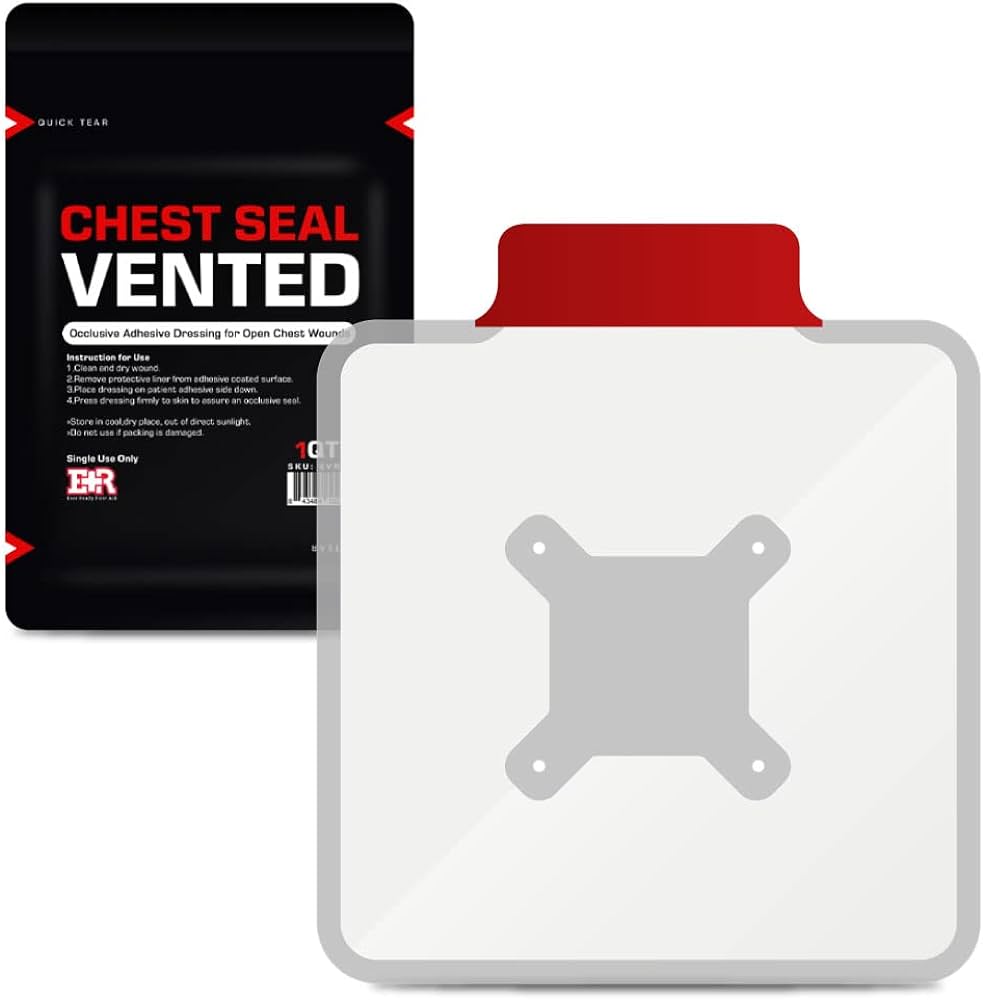
In situations where every second counts, having the right tools at hand can be the difference between life and death. Chest seals have proven to be a critical component of trauma kits, providing the means to quickly and effectively manage chest injuries.
Related Article: Jonathon Aldridge Talks EDC, TacMed, Training, and MORE!
By understanding the importance of chest seals, familiarizing yourself with their features, and knowing how to properly apply them in critical situations, you can help save lives and improve outcomes in emergency scenarios.
Remember, when it comes to chest injuries, immediate action and the right tools, such as chest seals, can make a world of difference. Get trained, understand how to use chest seals, and remember that you are your own first responder and that in an emergency scenario, you may be the first responder on the scene to help others.
If you’re looking for some good medical training that will teach you how to use your medical gear (such as chest seals), check out Bulletn.net for classes and courses in your area!
As a side note to close out this article, if you want to support our website and are in need of any tactical gear (or any product for that matter), anything you purchase using our links below will provide us with a small commission. We don’t charge for our free content and our goal is to keep it that way. We don’t have a Patreon account to put things behind a paywall, nor do we sell pics of our feet on OnlyFans.
If you choose to use the links below and make a purchase (at no additional cost to you), we greatly appreciate your support as it helps us continue to publish free content (like this article) on our website:
- Optics Planet (use code SAS5 at checkout for 5% off)
- Amazon
We have also partnered with CCW Safe. It’s the concealed carry coverage that I personally have for myself and my family in the event we need to defend our lives. Feel free to use our CCW Safe link to sign up and get some coverage to protect yourself and your family.
Also if you have a product you would like us to check out and potentially review, please contact us and let’s discuss.


*Disclosure: This article may contain affiliate links or ads, which means we earn a small commission at no extra cost to you if you make a purchase through these links. These commissions help support the operation and maintenance of our website, allowing us to continue producing free valuable content. Your support is genuinely appreciated, whether you choose to use our links or not. Thank you for being a part of our community and enjoying our content.
PLEASE CONSIDER SHARING THIS ON YOUR SOCIAL MEDIA TO HELP OTHERS LEARN MORE ABOUT THIS TOPIC.


